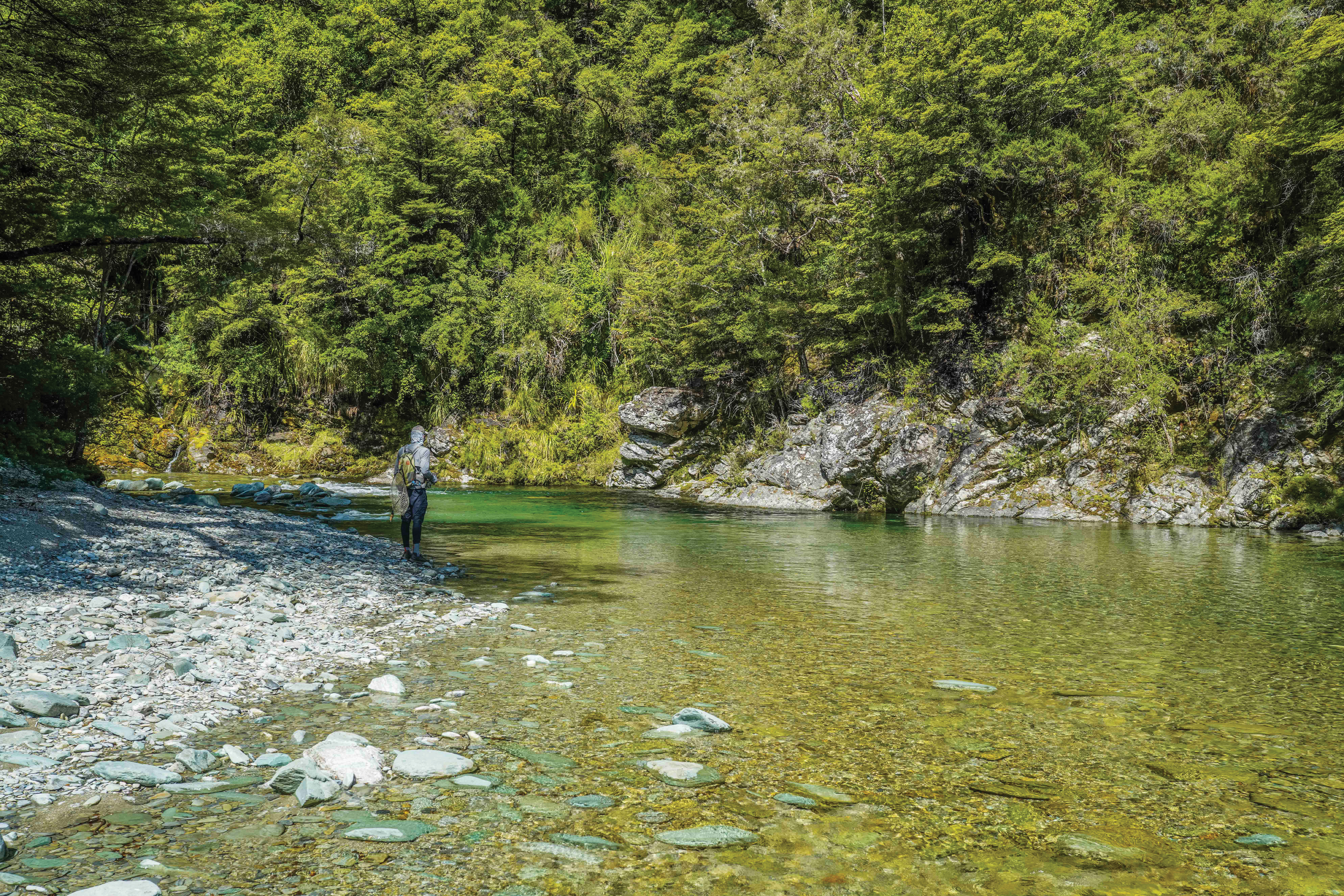
The Perfect Solution
There are few places on earth as beautiful as an emerald trout stream flowing quietly through the lush Southern Alps of New Zealand. Approaching a rock-studded pool, knowing there has not been another angler on that piece of water in at least a week, both excites and intimidates. Excites as you know the trio of trout the guide has just pointed out are all well north of the 5-pound mark; and intimidates because you know one sloppy cast on your part will send all three fish sulking to the bottom, ending any chance you might have at them that day.
This is the situation I found myself in earlier this year, fishing a South Island river well-known for large brown trout. Simply average fish here run a legitimate four to five pounds, and anglers will daily encounter hook-jawed brutes that make those fish look small. The three fish spread throughout the pool in front of me clearly fell into the latter group, and I was a bit on edge. There was a high gravel bank on the side of the stream I needed to fish from, meaning I would have to cast from shallow water, with the rocky wall making for a limited back cast trajectory. My presentations would have to be straight upriver, directly over the fishes’ heads. Worse yet, the morning glare was a wicked, impenetrable sheet. With absolutely no options, I was going to have to fish “blind”, completely dependent on the guide’s whispered directions coming down from his vantage point on the gravel promontory overhead. And there would be absolutely no margin for error.
As I crept down the steep scree bank, trying desperately not to let these fish get into my head before I even cast, the guide assured me all three fish were happy, and actively nymphing. Good news, to be sure…but also an opportunity I could lose with a single sloppy presentation. Once in place for the most downstream fish, I listened intently to his instructions, repeating every given distance and indicated shoreline twig and boulder back to him to make certain I had it right. Taking a deep breath, focusing intently on the spot I wanted my little tungsten-beaded nymph to land, I cast.
“Nice cast, mate, just perfect! Wait, wait…okay, he’s coming…coming…get ready!”
And…
… nothing.

I realized I had stopped breathing somewhere along the way, so certain was I that the tiny white indicator was going to disappear. Exhaling, deflated, I looked my question up to the guide, who just shook his head in bewilderment.
“Perfect cast, man, and the fish came for it. I was sure he was going to take! But he refused at the last moment, and I think he knew something was wrong. He’s gone.” I watched as he scanned the upper part of the run intently. “The good news is, those other two fish are still where they were, and still happy…we caught a bit of luck there.”
Disappointed, yet strangely relieved that I had not choked, I felt confidence seeping back into my core. I hadn’t hooked the fish, but had done everything in my control perfectly. It felt good. So we started the whole dance again on the next fish upstream, but this time when the time came to cast, I was confident. Again with the cast, and again the guide whispered excitedly to get ready…and again my indicator refused to duck down. Looking up, I watched my guide shrug in puzzlement. “Same deal,” he whispered, “but this time the fish is still there, and feeding. Don’t show him that same fly again, though – that would put him off, for sure.” So I put on a different small nymph, and cast once more. Again, there was no response.
“That cast was a bit short – I don’t believe he saw the fly. Try the exact same line, but three feet further. That should put it right – Oh! Hold on!” Looking up, I saw him suddenly crouch low to minimize his skyline silhouette. “There’s a new fish right underneath me – I have no idea where it came from! It’s a really nice fish, and only five feet off the bank, in deep water. He’s happy, but you’ll need a heavy nymph to reach him.”
Pulling out my fly box, I searched for a medium-sized nymph that could quickly sink to six feet in moderately heavy current…and saw my brand new, Jigged Poxyback Golden Stone. Perfect. With a large tungsten bead and relatively compact, weighted body, the fly would plummet. I knew I might only get one shot, and I wanted to be sure my fly at least sunk down to the trout’s depth, giving me a chance. There was no question this fly would accomplish that.
I could hear the excitement in my guide’s voice as he described where my cast needed to land – far enough above the fish to allow the nymph time to sink down, but not so far as to let it see the fly line. I could sense this fish was catchable, if the cast was right. Remembering to relax and breath, I shot out the cast…and my guide went strangely quiet. Had I blown the cast and spooked the trout? With no voice from above for the first time in our team effort, I could do nothing but strip in line as the indicator floated back down towards me.
And then it was gone.

I recall realizing the tiny bit of wool was under, and reacting with a fast sideways sweep of the rod…and the deeply satisfying feeling of coming tight to solid weight. The fish was large, and bull-strong – it tore up and down the length of the pool several times. All I could do was follow, stay tight and exert as much pressure as I dared. With the trout tiring, my guide nervously mentioned the fly seemed barely hooked, just in the tip of its prominent beak. I smiled to myself – I hadn’t mentioned to the guide I’d put on a fly tied on a jig hook, with one of the benefits being consistent hookups in fish’s upper jaws. I was confident the fly had found secure purchase. As the beast slid into the net, my guide gave a victory yell, and looked back at me with a smile that told me the fish was important to him, and that he was honestly happy for me. Reeling up line as I approached, I saw he was struggling to get the barbless hook out; succeeding, he looked closely at the fly. I explained the pattern, and was paid the ultimate compliment by his asking if I had any more of them in my box. And in fact, I did!
-Signature Tyer Mike Mercer
